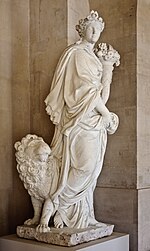Pig in the Chinese zodiac legend[edit]
According to the
myths, the Pig was the last to arrive when the
Jade Emperor called for the great meeting. Other sources said that
Buddha called for a great meeting when he was about to leave the
Earth. The Pig came in last.
Legend has it that just as the emperor was about to call it a day, an oink and squeal was heard from a little Pig. The term "lazy Pig" is due here as the Pig got hungry during the race, promptly stopped for a feast then fell asleep. After the nap, the Pig continued the race and was named the 12th and last animal of the
zodiac cycle.
[4]
Other sources say that given his very stout form, he was just too slow a swimmer, and thus he could not do anything against the other animals.
Years and the Five Elements[edit]
The Pig and the Elements[edit]
However, the Pig is
yin, and thus only the negative aspects of the
elements can be attached to them, thus only 5 kinds of Pigs are found in the
zodiac. They are the following:
- 乙亥 (yǐhài) – The Wood Pig
- 丁亥 (dīnghài) – The Fire Pig
- 己亥 (jǐhài) – The Earth Pig
- 辛亥 (xīnhài) – The Metal Pig
- 癸亥 (guǐhài) – The Water Pig
The Years of the Pig[edit]
People born within these date ranges can be said to have been born in the "Year of the Pig", while bearing the following
elemental sign:
[5]
| Start date | End date | Heavenly Branch |
|---|
| 4 February 1935 | 23 January 1936 | Wood Pig |
| 22 January 1947 | 9 February 1948 | Fire Pig |
| 8 February 1959 | 27 January 1960 | Earth Pig |
| 27 January 1971 | 14 February 1972 | Metal Pig |
| 13 February 1983 | 1 February 1984 | Water Pig |
| 31 January 1995 | 18 February 1996 | Wood Pig |
| 18 February 2007 | 6 February 2008 | Fire Pig |
| 5 February 2019 | 24 January 2020 | Earth Pig |
| 23 January 2031 | 10 February 2032 | Metal Pig |
| 10 February 2043 | 29 January 2044 | Water Pig |
The month and hour of the Pig[edit]
Month of the Pig[edit]
Aside from being assigned a year, the Pig is assigned to govern a month in the
Lunar calendar. As the
lunar month cycle begins in spring, the Pig is assigned to the 10th month, usually the time when winter begins. This
lunar month corresponds to the
Gregorian calendar as beginning from 7 November, and ending at 6 December.
People born in any year are said to inherit some attributes of the Pig if they are born during these months. Thus, in order to complete the
astrological reading, it is important to know this month as well.
Hour of the Pig[edit]
Given that the day is composed of 24 hours, each sign is given to the different signs of the
zodiac. The Pig is assigned to govern the time between 21:00 hrs to 22:59 hrs. According to
tradition, this is the time when the Pig is doing what it does best (sleeping and enjoying the sweet life).
In terms of
astrology, the hours in which people are born (technically termed as the
Ascendant) are the second most important
facet of their
astrology. Thus, this alters greatly the
characteristics. Even if people are born in any year governed by another animal (for example, anyone born on 20 December 2000, i.e. year of the
Dragon) will display strong
characteristics of the Pig. Thus, they may be fierce and strong like the
Dragon, but at the same time emotional and intuitive like the Pig.
Chinese Zodiac Pig Compatibility Grid[edit]
Relationship with other signs[edit]
The Pig belongs to the fourth
Trine of the
Chinese zodiac. It is most compatible with the
Rabbit. The gentle and sensitive
Goat is most compatible with the Pig. Also, two
Pigs can get along well with each other. It is said that the relationship between these three archetypes work best as they strive for aestheticism, beauty, and a more philosophical, and intellectual approach in life. Their calm
nature gives them great leadership abilities.
They are artistic, refined, intuitive, intelligent, and well-mannered. These souls love the preliminaries in love, and are fine artists in their lovemaking. The
Rabbit,
Goat, and Pig have been bestowed with calmer
natures than the other nine signs.
These three are compassionately aware, yet detached and resigned to their condition. They seek beauty and a sensitive love. They are caring, unique, self-sacrificing, obliging, sensible, creative, empathetic, tactful, and prudent. They can also be naive, pedantic, insecure, cunning, indecisive, and pessimistic.
The
Snake, is said to be incompatible with the Pig as the jovial
character of the Pig, and is opposite from that of the reserved and contemplative
Snake.
Basic astrology elements[edit]
| Earthly Branches Of Birth Year: | Hai |
| The Five Elements: | Water |
| Yin Yang: | Yin |
| Lunar Month: | Tenth |
| Lucky Numbers: | 2, 5, 6, 8; Avoid: 3, 4, 9 |
| Lucky Flowers: | Lily of each and every species |
| Lucky Colors: | yellow; Avoid: red, blue |
| Season: | Winter |
| Closest Western Zodiac: | Aries |
Cultural notes
Earth (classical element)
From Wikipedia, the free encyclopedia
Jump to navigationJump to search
European tradition[edit]
Empedocles of Acragas
(c. 495 – c. 435 BCE) proposed four
archai by which to understand the
cosmos:
fire,
air,
water, and
earth.
Plato (427 – 347 BCE) believed the elements were geometric forms (the
platonic solids) and he assigned the
cube to the element of
earth in his dialogue
Timaeus.
[1] Aristotle (384–322 BCE) believed
earth was the heaviest element, and his theory of
natural place suggested that any
earth–laden substances, would fall quickly, straight down, towards the center of the
cosmos.
[2]
In
ancient Greek medicine, each of the
four humours became associated with an element.
Black bile was the humor identified with earth, since both were cold and dry. Other things associated with earth and black bile in ancient and
medieval medicine included the season of
fall, since it increased the qualities of cold and aridity; the melancholic temperament (of a person dominated by the black bile humour); the
feminine; and the southern point of the compass.

Alchemical symbol for earth
In
alchemy, earth was believed to be primarily dry, and secondarily cold, (as per Aristotle). Beyond those classical attributes, the chemical substance
salt, was associated with earth and its
alchemical symbol was a downward-pointing triangle, bisected by a horizontal line.
Indian tradition[edit]
As
Prithvi Mata, or "
Mother Earth", she contrasts with
Dyaus Pita, "
father sky". In the
Rigveda,
earth and sky are frequently addressed as a
duality, often indicated by the idea of two complementary "half-shells." In addition, the element Earth is associated with
Budha or Mercury who represents communication, business, mathematics and other practical matters.
Ceremonial magic[edit]
Earth and the other Greek classical elements were incorporated into the
Golden Dawn system. Zelator is the elemental grade attributed to earth; this grade is also attributed to the
Qabbalisticsphere
Malkuth.
[3] The
elemental weapon of earth is the
Pentacle.
[4] Each of the elements has several associated spiritual beings. The archangel of earth is
Uriel, the angel is Phorlakh, the ruler is Kerub, the king is Ghob, and the earth
elementals (following
Paracelsus) are called
gnomes.
[5] Earth is considered to be passive; it is represented by the symbol for
Taurus, and it is referred to the lower left point of the pentagram in the Supreme Invoking Ritual of the Pentagram.
[6] Many of these associations have since spread throughout the occult community.
It is sometimes represented by its
Tattva or by a downward pointing triangle with a horizontal line through it.
Other traditions[edit]






